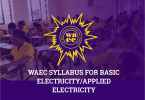The WAEC 2025 examinations for school candidates are set to begin very soon, and preparations are already underway. To help candidates get ready, WAEC has released the syllabus for all the subjects that will be covered in the exams. The WAEC syllabus for building construction is designed to guide you on the important topics to focus on and the ones you can skip, so you can use your study time wisely and effectively.
Below, you will find the WAEC syllabus for building construction. If this is one of the subjects you will be writing, make sure to download the syllabus in PDF format. We have also included a list of recommended textbooks to help you prepare better for the Building Construction exam.
Make good use of these resources, and share them with your classmates and tutors to support everyone’s success.
The Examination Structure
The exam comprises three papers, all of which are compulsory.
- Paper 1: 40 multiple-choice questions, worth 40 marks, to be completed in 45 minutes.
- Paper 2: Essay section with 5 structured questions—candidates must answer 4 in 1 hour, totaling 60 marks.
- Paper 1 and 2 will be taken together as a composite paper lasting 1 hour 45 minutes and carrying 100 marks.
- Paper 3: A Building Drawing paper lasting 2½ hours and worth 100 marks. It includes 4 questions—1 compulsory (40 marks) and 2 others to be chosen from the remaining 3 (30 marks each).
WAEC Syllabus for Building Construction
| S/NO | CONTENT | NOTES |
|---|---|---|
| 1 | Introduction to Building | (i) Definition of building (ii) Classification and types (iii) Introduction to National Building Codes (Building regulations and Byelaw requirements) |
| 2 | Building Construction and Construction Team | (i) Definition, purpose, and procedures for building construction (ii) Parties in the construction team (Client’s team, contractor’s team, and statutory personnel) (iii) Functions of the team members (iv) Relationship of the parties |
| 3 | Safety Practices | (i) Definition of safety, rules, and regulations (ii) Hazards in the workshop and construction site (iii) Causes and methods of accident prevention (iv) Safety equipment and measures at construction site (v) First aid equipment, procedures, and safety wears (vi) Safety in working with dangerous equipment and materials (electricity, scaffolding, formwork, cement, roof, etc) |
| 4 | Basic Tools, Equipment, and Machines | (i) Identification and functions of basic tools and equipment (ii) Care of tools and equipment |
| 5 | Site Clearing and Levelling | (i) Operations involved in site clearing (ii) Tools and equipment for site clearing and levelling (iii) Basic site levelling operations |
| 6 | Site Organization and Layout | (i) Preliminary operations in building construction (ii) Procedure for site layout (iii) Location, boundary lines, hoarding, hutments, and access road |
| 7 | Setting Out | (i) Methods of setting out (3:4:5 method, Builders’ square method) (ii) Tools and equipment for setting out (iii) Procedures for setting out |
| 8 | Building Drawing | (i) Use of drawing tools and simple exercise on plane geometry in relation to building (ii) Building drawing symbols (iii) Scales used in building and their application on site (iv) Production drawings and interpretations (Plans, Elevations, sections, and details) (v) Special details (detailing building elements, including doors and windows schedule) (vi) Scaling (Enlargement, pictorial, and perspectives) (vii) Definitions and use of Auto-CADD |
| 9 | Excavation and Earth-Work | (i) Classifications, types, and properties of soil (ii) Definition and function of excavation (iii) Methods of excavation (iv) Tools, equipment, and plant used for excavation (v) Solutions to excavation problems (Earthwork support, timbering, batterin,g and dewatering) (vi) Safety rules during excavations |
| 10 | Foundation | (i) Definition, purpo,se and functional requirement of foundation (ii) Types of foundation (iii) Factors that determine choice of foundation |
| 11 | Ground Floors | (i) Types, functions, and functional requirement of ground floor (ii) Methods of construction ground floor (iii) Definition of basement (iv) Explain differences between building with basement and without basement (v) Problems relating to basement in a building |
| 12 | Suspended Floors | (i) Definition and functions of upper floor (ii) Methods of construction (concrete floors and timber upper floors) |
| 13 | Concrete | (i) Definition and types of concrete (ii) Materials for concrete (iii) Definition, types, components and manufacture of cement; properties and uses of cement including alternatives (e.g., Pozzolana, P.F.A., R.H.A) (iv) Types and uses of aggregates (e.g., palm kernel shell, periwinkle) (v) Types and uses of reinforcements (vi) Properties and characteristics of concrete (vii) Process of concrete production (viii) Types of concrete tests |
| 14 | Walls | (i) Definition, types, and functions of walls (ii) Definition, types, and properties of walling materials (including local materials) (iii) Manufacturing processes of walling materials (clay, brick, blocks, concrete blocks) (iv) Sizes of blocks and bricks (v) Mortar mixes for brick (vi) Methods of wall construction (vii) Timber wall construction (viii) Definition and function of wall openings (ix) Methods of constructing wall opening (x) Functions of lintels and arches |
| 15 | Doors and Windows | (i) Definition, functions and types of doors and windows (ii) Methods of mixing doors and window frames |
| 16 | Staircases | (i) Definition, classification, types and uses of stairs (ii) Materials used for construction of stairs (iii) Materials used for finishing staircases |
| 17 | Plumbing Installations and Drainage System | (i) Types of fittings in plumbing and sanitary works (ii) Materials for plumbing works and fittings (iii) Types of sanitary appliances (iv) Soil and waste appliances (v) Installation of sanitary appliances (vi) Terms used in drainage works (vii) Principles and functional requirements of drainage system (viii) Types of drainage system (ix) Types of drainage materials (pipes and fittings) (x) Methods of laying and testing drain lines (xi) Description of septic and soakaway (inspection chamber, manhole, etc) |
| 18 | Electrical Installation and Solar Energy System | (i) Electrical symbols, installation terms and materials (ii) Identification and uses of electrical wiring materials (iii) Types of electrical wiring (iv) Definition, functions and components of solar energy systems |
| 19 | Roofs | (i) Definition, purpose and types of roof (ii) Functional requirements of roof (iii) Materials used for roofs (iv) Roof covering materials (v) Protection of roof from wind, rain, lightning, etc |
| 20 | Finishes | (A) Floors: (i) Types and characteristics of floor finishes (ii) Methods of laying floor finishes (iii) Uses of floor finishes (iv) Care and maintenance of floor finishes (B) Walls: (i) Types and characteristics of wall finishes (ii) Plastering and rendering (iii) Types of rendering (iv) Methods of applying plastering and rendering mix (C) Ceiling: (i) Types and functions of ceiling finishes (ii) Ceiling finishing materials |
| 21 | External Work | (i) Types of fence, materials for fencing and construction of fence (ii) Types of gate, fixing of gates and production of gate (iii) Types and materials for construction of access roads (iv) Construction of access road (v) Needs and materials for landscaping (vi) Procedures for landscaping |
| 22 | Types of Business Organization and Ways of Raising Capital | (i) Principles and Management of Business Organization in the building industry (ii) Types of Business Organization in the Building Industry (iii) Types and sources of Capital |
| 23 | Book Keeping | (i) Book Keeping in small scale businesses (ii) Books of original entries |
| 24 | Contract Work | (i) Definition and types of contract (ii) Contract documents (iii) Parties to a contract |
Recommended Texts For Building Construction
- Emmitt, S., & Gorse, C. A. (n.d.). Barry’s introduction to construction in buildings. Blackwell Publishing.
- Obande, M. O. (n.d.). Blocklaying and concreting. Longman Publishing Company.
- Barry, R. (n.d.). The construction of buildings (Vols. I–V). Granada.
- Seeley, I. H. (n.d.). Building technology. Palgrave.
- Ezeji, S. C. O. A. (n.d.). Building construction.
- Nash. (n.d.). Brickwork (Vols. 1–3).
- Chudley, R. (n.d.). Building construction handbook. Billing & Sons Ltd.
- McKay, W. B. (n.d.). Building construction (Vols. 1–4).
- Greeno, R. (n.d.). Principles of construction.
- Adesokan, & Adeniyi, M. O. (n.d.). Building construction for senior secondary schools (Vols. 1–3). Ilesanmi.
- Chudley, R. (n.d.). Construction technology (Vols. 1–4). Longman.
- Barritt, C. M. H. (n.d.). Advanced building construction (Vols. 1 & 2). Longman.
- WAEC Past Questions For Building Construction
Please ensure that you use this syllabus carefully and wisely. Along with practicing past questions, these resources are key to helping you succeed in the examination. We encourage you to share the syllabus with your fellow candidates and tutors to maximize everyone’s preparation. If you have any questions, feel free to ask in the comments below, and we will respond promptly. Good luck!







Leave a Comment